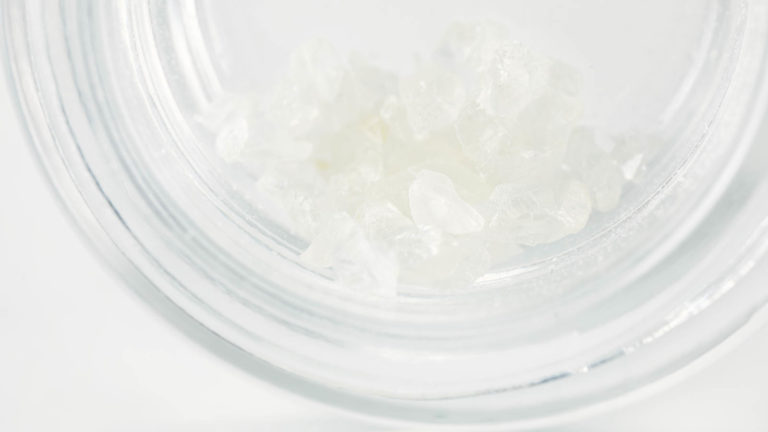The purest form of cannabis concentrate, this extract consists of a single type of cannabinoid, usually tetrahydrocannabinolic acid (THCA), cannabidiolic acid (CBDA), or cannabidiol (CBD). Crystalline is formed by thoroughly refining cannabis oil into a single compound; it serves as a base for formulated cannabis products. While possibly more potent, crystalline lacks the flavor of other concentrates and some of the potential medicinal benefits due to its isolation from the original terpenes.
Crystalline — also referred to as crystals, THC crystals, or diamonds — is a cannabis concentrate that comes in a solid state. CBD crystalline is often referred to as CBD isolate. Regardless of the cannabinoid, crystalline resembles coarse sugar, the kind typically used for decorating sugar cookies or glittering the tops of baked fruit pies. Crystalline is free of plant matter or terpenes, which are the distinct aromatic and flavor qualities of a cannabis cultivar, or strain.
What cannabinoids are available in crystalline form?
Crystalline is produced to have just one cannabinoid. The only cannabinoids available in crystalline form are THCA, CBDA, and CBD. Consuming THCA, CBDA, or CBD does not produce an intoxicating high, though THCA converts to THC when exposed to heat, making the crystalline intoxicating.
What is THCA crystalline?
You may have heard the term THC crystals or THC crystalline used to describe crystalline. But THC, which produces an intoxicating high, is not available as crystalline because, chemically, THC cannot hold a crystalline structure. In other words, what's often referred to as THC crystals is not pure THC, but rather pure THCA. THCA crystalline converts to active THC through decarboxylation if it's heated at the time of consumption.
While THC doesn't hold a crystalline structure, CBD does. That's why you won't see THC crystalline but CBD crystalline, or isolate, is readily available.
 Photo by: Gina Coleman/Weedmaps
Photo by: Gina Coleman/WeedmapsImage lightbox

Is crystalline better than other concentrates?
When exposed to heat, THC crystalline is quite potent, though you may not experience the full effect of this extract, as it lacks the terpenes found in flower and other concentrates. Terpenes help provide the unique flavors, aromas, and effects associated with different cultivars. Without terpenes, crystalline isn't able to provide the same benefits because of what's known as the entourage effect.
Terpene removal is part of the crystalline production process and the resulting cannabinoids in the final product are the same, regardless of the starting plant material. For example, if a crystalline manufacturer used Durban Poison cultivar for one batch of THCA crystals, and Northern Lights for a separate batch of THCA crystals, the final products would produce the same effects. The isolated THCA crystals from one strain are identical to those from another. Dispensaries won't carry strain-specific crystals; they simply don't exist because THC or CBD crystalline has no terpenes to give the strain its unique characteristics.
How can crystalline be used?
Crystalline can be ingested orally, either by adding it to a recipe when making edibles, or dissolving it in oil to create a tincture-like product. For homemade edibles, crystals can be dissolved in cooking oil or butter and used as an ingredient in recipes. Olive oil and coconut oil are the most popular bases for making crystalline tinctures.
Crystalline can also be smoked or dabbed using a dab rig. A dab rig is a type of smoking apparatus, similar to a small water bong, that vaporizes heated crystalline so it can be inhaled in single, measured doses.
THCA crystalline can also be combined with other cannabis concentrates, like budder or shatter, to increase their potency. Mixing crystalline with concentrates that have terpenes and other cannabinoids may aid the uptake of the THCA, CBDA, or CBD into the body.
 Photo by: Gina Coleman/Weedmaps
Photo by: Gina Coleman/WeedmapsImage lightbox

How is crystalline made?
Warning: The manufacturing of crystalline should only be performed by skilled professionals as the process can be extremely dangerous and illegal in many jurisdictions.
Crystalline is produced from a cannabis extract. The starting material for THC crystal extraction can come from raw cannabis plants. The production of cannabis crystalline is essentially the process of mixing a refined cannabis concentrate with a solvent, then applying specific heat and pressure conditions to evaporate the solvent, allowing crystals to form. For example, if THCA crystalline is being produced, any THCA will precipitate, or separate, out of the solution. Under the right temperature and pressure conditions, the THCA will chemically bond to other THCA molecules, forming crystalline structures.

